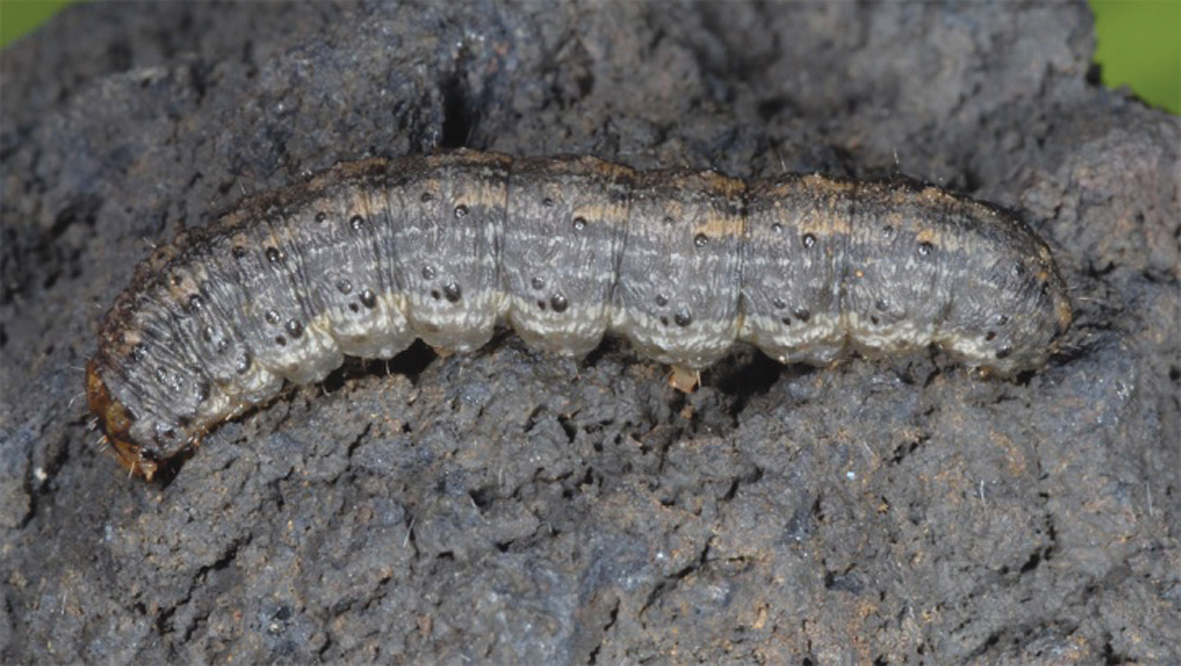September 2024
|
HIRESH RAMANAND, |
 |
THERE ARE SEVERAL AGROTIS CUTWORM SPECIES (LEPIDOPTERA: NOCTUIDAE) PRESENT IN SOUTH AFRICA, NAMELY BLACK CUTWORM (AGROTIS IPSILON), GREY CUTWORM (AGROTIS SUBALBA), BROWN CUTWORM (AGROTIS LONGIDENTIFERA), SPINY CUTWORM (AGROTIS SPINIFERA) AND THE COMMON CUTWORM (AGROTIS SEGETUM). THE COMMON CUTWORM IS THE MOST PROMINENT AND ECONOMICALLY IMPORTANT SPECIES PRESENT IN SOUTH AFRICA.
THE IMPORTANCE OF CUTWORM MANAGEMENT
SCOUTING IS NECESSARY
MANAGEMENT STRATEGIES
Genetically modified maize (Bt)
While genetically modified (Bt) maize is effective against stalk borers, it is ineffective when it comes to cutworm. The reason is simple – cutworm and stalk borers are different species. Cry proteins in Bt maize are species-specific. In addition, as with insecticides, the size of the larvae being treated is crucial. Therefore, the bigger the larvae, the less effective the cry protein.
Cutworm larvae that target maize seedlings are generally large, late-instar larvae. Farmers must be vigilant of any seed companies claiming that the Bt gene will control cutworm larvae – this is patently false based on the reasons highlighted, as well as the fact that there are no legal registrations for this purpose.

Characteristic cutworm larva damage to a seedling.
Photo: Clemson University – USDA Cooperative Extension Slide Series, Bugwood.org

The larvae are dirty-grey or brown in colour with a smooth, waxy appearance.
Photo: http://www.pyrgus.de/Agrotis_segetum_en.html
Controlling weeds is crucial
Conventional practices of tilling in the form of ploughing, well before planting, are aimed at destroying winter weeds and any volunteer plants present in a crop field. The larvae that become buried or exposed on the soil surface may be damaged, injured or preyed on.
Weed control through the responsible application of registered herbicides prior to planting is the commonly used method to manage cutworm larvae in reduced and no-tillage systems.
Weed control in this context is crucial to deny newly hatched larvae a food source in the absence of crops. In general, a minimum of 35 weed-free days prior to planting (where practically possible) are required to starve larvae. While farmers may not have weeds at the time of planting, the presence of weeds four to five weeks prior will exacerbate cutworm issues. Therefore, in almost every situation, insecticides must also be used for effective cutworm management.
Farmers who plant maize cultivars with herbicide tolerance, probably must wait for seedling emergence before applying an herbicide. This is also true for insecticides.
Insecticides
Applications of suitably registered pyrethroids and organophosphates are considered essential in controlling cutworm larvae infestations. When applied preventatively at planting, it is important to monitor after spraying, especially during emergence and throughout the seedling stage to determine if a second application may be required.
Importantly, many pesticides registered for use against cutworm make it clear that where reduced or no-till is practised, particularly with maize, populations of cutworm can be expected to be higher where scouting after spraying is crucial to determine if a second application is required.
When using an insecticide against cutworm larvae, keep the following in mind:
CONCLUSION
Cutworms have been relatively well managed in the country to date and there is no doubt that this will continue. Although there have been isolated issues recently, the Insecticide Resistance Action Committee (IRAC) remains firm about the fact that there is no resistance issues with registered pyrethroids, given the available information.
Farmers must strictly adhere to product label instructions without deviation in any manner whatsoever when applying a pesticide, whether a herbicide or an insecticide. The label of a pesticide product is the law in terms of the Fertilisers, Farm Feeds, Agricultural Remedies and Stock Remedies Act, 1947 (Act No. 36 of 1947). It is important to read the label instructions carefully.
Product registration holders have done copious amounts of research to compile the label instructions and if not strictly followed, then efficacy against the target pest, in this case cutworm, cannot be guaranteed.
Further, guard against irresponsible tank mixing and consider the conditions of the spray water in terms of the hardiness and pH in relation to the product label instructions.
Finally, farmers are encouraged to keep records of pest experiences linked to climatic conditions, given that the influence of soil moisture on factors such as cutworm biology and behaviour is often overlooked. This will enable farmers to better anticipate and prepare for potential issues in following seasons.
For more information, send an email to CropLife SA at info@croplife.co.za.
Publication: September 2024
Section: Pula/Imvula